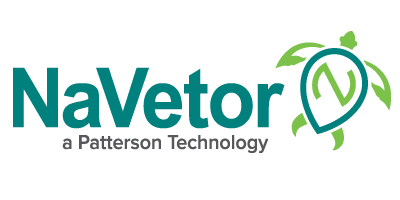Cloud practice management software has become mainstream and popular in the veterinary industry. But, we still get quite a few questions about cloud software, particularly around security. We’ve organized the five most-common cloud myths that we see among veterinary practices, with the facts that set them straight.
Cloud Myth #1: My data isn’t secure in the cloud.
If you’ve considered switching to the cloud, you’ve probably wondered how secure the cloud really is. That’s understandable. When veterinarians are charged with protecting sensitive client and patient data, the idea of storing clinic data in the cloud can seem risky.
The good news … at Patterson, our cloud software, NaVetor, uses bank- and government-level security to safeguard important practice data. It’s like the inside of a maximum security facility, protected by steel walls and an electric fence. Perpetrators would need to disable and clear both the electric fence and the thick steel walls to get inside. Then the perpetrator would need to break through a highly secure vault to obtain your data.
None of those steps are easy. One could argue that it might be easier for a thief to break into your practice and steal your local server and computers, than to break into a maximum security cloud server.
Cloud Myth #2: With cloud software, I don’t own my data, and others can access it.
We can’t speak to other companies’ policies, but we can share our policies at Patterson. We believe that the data in your software belongs to YOU alone. We do not share your data with anyone else without your consent.
No matter which software system you choose, it is always important to review the end-user license agreements carefully to understand how your data can be used and the steps taken to protect it. Software providers should be 100 percent transparent with you on how your data is owned and used.
Cloud Myth #3: I have to be paperless to switch to cloud.
This is a myth we hear a lot. In truth, veterinary practices can be as paper light or paper heavy as they want. Going paperless is not a requirement for cloud computing. Having a cloud-based software simply means that your practice data is stored securely in the cloud, and you can get to it from any computer or mobile device.
Certainly, good cloud programs like NaVetor have robust electronic medical records where you can store complete patient health information, maintain treatment plans, and attach images from radiographs, so you can go paperless if you want. But you can also keep paper files if that’s your preference.
Cloud Myth #4: I can’t run my practice if the Internet goes down.
We work with a large number of veterinary practices each year, and the truth is, Internet outages don’t happen that often. How reliable is the Internet at your practice? That’s a good indicator of how successful a cloud software product will be for your practice. Internet capability and reliability has increased significantly since even a couple of years ago, so chances are that most clinics will have reliable Internet, and therefore reliable cloud software, 99 percent of the time.
If your Internet does go down for a short time period, you can use the NaVetor mobile app to run your practice during the interim, or you can turn a mobile phone into an Internet hotspot as a backup.
Cloud Myth #5: Cloud software is more expensive than server-based software
This is a big myth and is certainly worth calculating based on your practice’s IT needs. Here are the costs that you’ll want to include in your calculations:
Server-based software requires several components, including:
- The cost of the software itself (a one-time fee)
- The cost of any related licenses, such as Microsoft® SQL
- The cost of a server and one or more workstations
- IT and networking support (since you’ll need all workstations to connect with the server)
- Software annual support costs, which covers technical support and all updates
- Online, offsite backup of your practice data, in addition to your local server backup
Assuming that you’ll need five workstations that will require replacement every five years or so, you could spend $20,000 or more during your first year and $100,000 or more after 10 years (cumulative).
Let’s compare this to cloud software requirements. When switching to cloud software, you will need:
- A monthly cloud software subscription, which covers tech support, software updates, and online data backups.
- One or more workstations. With cloud, you have more flexibility to use less expensive laptops and/or tablets as some of those workstations.
- High-speed internet service.
Assuming an average monthly cost of $300 for the cloud software and $100 for high-speed Internet, and assuming that your five laptops or tablets will also need to be replaced every five years, you might spend between $5,000 and $10,000 during your first year and $50,000 to $60,000 over a ten-year period.
That can add up to some healthy savings, so it’s definitely worth crunching the numbers for your situation.
| Year 1 | Year 2 | Year 3 | Year 4 | Year 5 | Year 6 | Year 7 | Year 8 | Year 9 | Year 10 | Year 11 | |
|---|---|---|---|---|---|---|---|---|---|---|---|
| Server | |||||||||||
| Cloud | |||||||||||
| Annual Savings |
If you’d like more information on the cost of NaVetor cloud software for your practice, request a demo or contact our sales team at sales@navetor.com or 877-422-8838.

